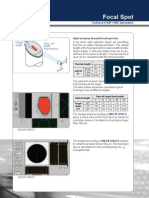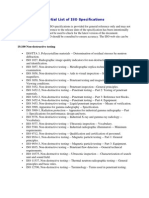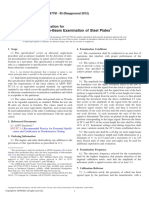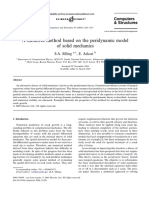Measurement of Prep Ene Trant Etch
Measurement of Prep Ene Trant Etch
Uploaded by
PDDELUCACopyright:
Available Formats
Measurement of Prep Ene Trant Etch
Measurement of Prep Ene Trant Etch
Uploaded by
PDDELUCACopyright
Available Formats
Share this document
Did you find this document useful?
Is this content inappropriate?
Copyright:
Available Formats
Measurement of Prep Ene Trant Etch
Measurement of Prep Ene Trant Etch
Uploaded by
PDDELUCACopyright:
Available Formats
Feature
From Materials Evaluation, Vol. 66, No. 12, pp: 1234-1240.
Copyright 2008 The American Society for Nondestructive Testing, Inc.
Measurement of Pre-penetrant Etch Rate
by William L. Glass*
INTRODUCTION
ost penetrant testing specifications
go into great detail about how to
control the penetrant materials, the
equipment and the process, but some say little about how to control pre-penetrant etching. For example, paragraph 7.1.5 of ASTM
E 1417-05 says Etching processes shall be
developed and controlled to prevent damage to components under test (ASTM,
2005). Statements like this leave the controls and degree of control wide open. Who
agrees to whatever is developed? Nadcap
mandates much of what we do at our business, such as the statistical process control.
This is because we also perform chemical
milling, macro-etching and passivation,
and we are required by most of our customers to have chemical processing approval from Nadcap. Nadcap does not require these same controls for NDT labs or
manufacturers that perform their own
etching in support of their penetrant testing. So how does the NDT industry control
etching when there may be only limited
specification requirements? This paper is
limited to how we measure etch rate at our
particular business: perhaps some of the
questions brought up herein will inspire
others to write about some of their own
etching control methods. Important equations are discussed in the body of the
paper, with their derivations given in the
appendices.
TYPICAL SURFACE STOCK REMOVAL
REQUIREMENTS
Typical surface stock removal requirements for pre-penetrant etching range from
1.27 to 17.78 mm (0.05 to 0.7 mil) per surface. We all know that an etched surface
will have a fogged appearance, and the
greater the etching the greater the fogging. While many of the controlling specifications say how to measure the etch
* ST&I Inc., 7517 Jefferson St., Paramount, CA
90723; (562) 634-6396; fax (562) 634-1754;
<wlglass@pacbell.net>.
1234 Materials Evaluation/December 2008
rate, almost none require measuring the resulting stock removal on the etched part.
The removal from the part is usually assumed to be what the etch rate said it
should have been. This is probably the best
approach, as mechanically measured removal values are not trustworthy for reasons discussed later. However, this means
that control of etch rate and visual testing
of the etched surfaces is very important.
So how does the NDT
industry control etching
when there may be
only limited
specification
requirements?
At our workplace, we have seen parts
etched for the required time (as measured
by an etch rate tab) come out of the etching
tank bright and shiny and un-etched.
There was some difference in the parts surface (texture/condition/contamination)
that prevented the part from etching at the
same rate as the tab. The operator must be
trained to recognize this condition when it
occurs and to bring it to the attention of
quality and/or management. Bright and
shiny is never acceptable (though this leads
to questions about pre-etch cleaning controls and personnel training, which will not
be covered in this paper).
Etch rate, therefore, is a major controlling factor of the process. What then are
some of the factors affecting etching rate
and how should etch rate be measured?
UNITS OF ETCH RATE MEASUREMENT
First, lets talk about the units of etch rate
measurement. Most American specifications express etch rate in inches per surface
per minute, inches per surface per hour, mils
per surface per minute or mils per surface
per hour. This results in number like
0.00008 in./surface/minute or 0.08 mils
/surface/minute (a mil being 0.001 in.). Because of the quantity of zeros in these numbers, they are difficult to handle when doing
a calculation for the required total etching
time. The error of dropping or adding a zero
in the required time calculation will result in
an error of a factor of 10 in the answer. If the
operator does not catch this error, the results
can be disastrous, and it is very easy to add
or drop a zero when recording such numbers or when entering such numbers into a
calculator or a computer.
Since most requirements for stock removals are something like 5.08 to 10.16 mm
(0.2 to 0.4 mil) per surface, we measure and
record etch rate in minutes required to remove 2.54 mm (0.1 mil) of stock per surface.
An etch rate of 2 mm (0.08 mil)/surface
/minute is the same as 1.25 minutes to remove 2.54 mm (0.1 mil)/surface (the required removal divided by the etch rate). If
the target stock removal is 7.6 mm (0.3 mil)
/surface, then the calculation for the required etching time is simply 3 1.25 =
3.75 min, and you can do the calculation (in
mils) in your head. If the etch rate was
0.15 mm (0.006 mil)/surface/minute, that is
16.7 min to remove 2.54 mm (0.1 mil), and
the required etching time is 3 16.7 =
50.1 min. While you may not be able to do
this calculation in your head, you can multiply 3 15 in your head to get 45 and thus
know that the answer is a little more than
45 min. Now, if you make a calculation
error and come up with an answer of 5.01
or 501 min, you will realize that a mistake
was made. For these reasons you may
want to measure your etch rate in minutes
to remove 2.54 mm (0.1 mil) of stock per
surface. Also, a number like 1.25 has a more
intuitive meaning to most people than a
number like 0.00008.
Figure 1 Individual control chart for a given tank (no temperature correction).
ETCH RATE AND STATISTICAL
PROCESS CONTROL
Our working practice is to perform an
etch rate on each standing tank in the
morning and at the end of each working
day. A standard etch rate tab (explained in
the next section) is used for each etching
tank and the data (in minutes to remove
2.54 mm [0.1 mil] per surface) is tracked statistically using X-MR charts. While tank
chemistry is checked on a specific schedule,
the chemistry is also examined or adjusted,
or the solution replaced, based upon this
statistical etch rate control. Even if the
chemical analysis says the etching solution
is good, if the etch rate is not in statistical
control the solution is adjusted or replaced
(Figure 1).
THE ETCH RATE TAB
Production etch rate is normally measured on a test tab of the same or a similar
alloy as the production part. Sometimes,
this test tab comes from the trim area of the
part. Most often, it is a piece of flat plate
stock assumed to be representative of the
part. This assumption may or may not be
true. There are many factors that affect the
rate of etching of a test tab, including tank
temperature, location of the tab in the tank
during etching, etch solution agitation rate
and the tabs surface finish.
STANDARD FLAT PLATE TEST TABS
AND MECHANICAL MEASUREMENT
Unless otherwise specified, we use etch
rate tabs made from plate stock of common
alloys of known density. The tabs measure
51 by 102 mm (2 by 4 in.) and are 1 to 2 mm
(0.04 to 0.08 in.) thick (the aluminum tabs
are 76 by 76 mm [3 by 3 in.]). These are our
standard test tabs mentioned earlier. In the
past, we measured the tab thickness before
(T0) and after (TF) etching with a microthickness gage (to 2.54 mm [0.1 mil]). Etch rate
(R) was then:
(1)
T0 TF
2te
measured in inches/surface/minute,
with te being etch time.
This is probably the most common
etch rate calculation method, but our experience is that it is very inaccurate. The
operator tends to get the final thickness
measurement (TF) he or she needs to obtain the expected etch rate by repeating
measurements using different thickness
gage closing pressures, or at different
spots on the tab, until the expected value
is obtained. Weve all done it. This is why
thickness gage measurement methods for
verification of small amounts of stock removal on production parts are unreliable
(though they can be fine for chemical
milling, which removes more material).
Also, we used the same tab over and over
again (with no conditioning between
runs) until the etched surfaces of the tab
were badly attacked by the repeated etching. At some arbitrary point, the tab surfaces were ground with a hand grinder
down to shiny parent metal and the
process repeated all over again. This resulted in tabs that were no longer flat and
that no longer had parallel surfaces. This
only exaggerated the microthickness gage
measurement problem. The results? Our
etch rates fluctuated wildly, and if you do
this yours do, too. It is doubtful whether
anyone discards the tab after a single use,
so the problem remains.
STANDARD FLAT PLATE TEST TABS
AND WEIGHT LOSS MEASUREMENT
To get around the thickness gage problem, our test tabs are now weighed on an
analytical balance to the nearest 0.1 mg, both
before and after etching. To get around the
inconsistency of the test tab surface finish,
the tab surfaces are grit blasted prior to each
use. The tab is blasted with100-mesh silicon
dioxide grit at 448 kPa (65 lb/in.2) with the
nozzle at about a 45 angle 51 to 76 mm (2 to
3 in.) from the surface. Blasting is performed
in one direction, then the tab is turned 90,
re-blasted, turned over and the blasting
process repeated on the other side. The tabs
are blasted just prior to etching and no other
cleaning is performed on the tab other than
wiping off the dust with a clean paper
towel. Also, the grit-blasting unit is used
only for test tab preparation. This makes
the tabs re-usable, as the surface finish is
the same each time. After the tabs fall
below a specified weight, they are discarded and replaced.
TAB AND PART SURFACE FINISHES
Standardizing the etch tab preparation
process as described above creates another
potential problem, however. The surface finish of our blasted test tab is usually not the
same as that of the production hardware,
which is usually machined. Where necessary, our formula for calculating the etching
rate has a built-in correction factor for this.
We have found that there is practically no
difference in our measured etch rate for
blasted versus non-blasted tabs of nickel, titanium and steel alloys. However, a blasted
aluminum tab etches about 1.4 times faster
than a non-blasted tab. So when calculating
the etch rate (in minutes to remove 2.54 mm
[0.1 mil] surface) for machined aluminum
parts, the tab etch rate is multiplied by 1.4.
TEST TAB LOCATION IN THE TANK
AND ETCHING TIME
The tab is introduced into the etching
tank at the same location every time. Our
tanks are air-agitated, so we have a sequence of air valves: one preset and locked
in a partially open position and the other
fully opened when the tank is in operation
(fully closed when not). This provides the
same amount of agitation at all times. Some
specifications recommend that a tank be agitated for a period of time, such as 15 min,
just prior to use and then that the agitation
be shut down during the etching period. We
have not experimented with this but think
that this approach might be a problem for
parts with large surface areas and for geometrically complex parts. We use constant
agitation based on our own experience. It
should be noted that in the past we performed a failure mode and effects analysis
study that indicated that the best etching
time to use for our etch rate measurement
was 20 min. The most commonly used etch
rate measurement time is probably 15 min.
We use 20 0.5 min.
STANDARD AND NON-STANDARD
TAB CONFIGURATIONS AND USAGE
Next comes the configuration of the etch
rate tab. If the part alloy is the same as one of
Materials Evaluation/December 2008 1235
surface was 1.8 min. To remove 7.62 mm
(0.3 mil)/surface, a total etching time of 1.8
3 = 5.4 min would be required. We would
round this off to 6 min. As previously noted,
we statistically track the time to remove
2.54 mm (0.1 mil) per surface, and for this tank
the grand average (X-bar) is 1.8 min with a
range of 0.12 min.
(a)
(b)
(d)
(c)
Figure 2 Tabs: (a) thin, flat; (b) thick, flat; (c) long cylindrical; (d) short cylindrical.
our standard test tabs, great! If not, what
then? There are several approaches for measuring and calculating the etch rate using
various configurations of etch rate tabs.
Thin, Flat Plate Tabs of Known Alloys
For a thin, uniform piece of plate stock
(Figure 2a), of a known alloy with a known
density, the etch rate can be calculated from
the following equation:
(2)
R=
WO WF
454 ( AS ) ( 2 )( d ) (te )
R=
W
454 ( AS ) ( 2 )( d ) (te )
or
(3)
where
WO = original weight (in grams)
WF = final weight (in grams)
454 = the approximate number of
grams in a pound
d = density (in pounds per cubic inch)
AS = surface area (in square inches [the
2 reflects the fact that there are two
surfaces being etched])
te = etching time (in minutes)
W = the weight differential (original
weight minus final weight)
the resulting etch rate is in inches per surface per minute.
This calculation ignores the area of the
edges of the tab and is probably the second
or third most common method of calculation for measuring etching rate. It works
only for tabs with large surface to thickness
ratios. In SI units, the equation would be
(4)
R=
W
( AS )( 2)( d )(te )
See Appendix 1 for the derivation of this
equation.
For a 51 by 102 by 2 mm (2 by 4 by
0.08 in.) tab, the surface area to thickness
ratio is 100 to 1 (2 4 / 0.08); ignoring the
surface area of the edges creates a 5.7%
error in the etch rate value. This comes
from the following. The assumed total surface area of 103.22 cm2 (16 in.2) divided by
the actual total surface area of 109.42 cm2
(16.96 in.2) equals 0.943, which when subtracted from 1 and multiplied by 100%
gives a 5.7% error. The surface area to thickness ratio should be no less than 100 to 1. A
thinner 51 by 102 mm (2 by 4 in.) tab would
have an even greater surface area to thickness ratio. The tab, then, should be no
thicker than 2.032 mm (0.080 in.).
For example, for a 51 by 102 mm (2 by
4 in.) UNS R56400 (6-4 Ti) tab that has a density of 4.49 g/cm3 (0.162 lb/in.3) and using a
20 min etching time, the etch rate becomes:
W
R=
(5)
23 535
and the time (t) in minutes to remove
2.54 mm (0.1 mil) per surface is
(6) t =
0.0001 0.0001 23 535 2.3535
=
=
R
W
W
(we actually use 2.350). We use the equations in Table 1 to calculate the time to remove 2.54 mm (0.1 mil) per surface for the
noted alloy families.
To take another example, our titanium
etch tank had a standard UNS R56400 (6-4 Ti)
tab with a starting weight of 26.1389 g, and a
final weight of 25.8003 g, which gave a W of
1.2737 g in 20 min. The etch rate (R) was then
1.3767 mm (0.05420 mil)/surface/min and the
time to remove 2.54 mm (0.1 mil) of stock per
Thin, Flat, Non-standard Alloy Tabs
What if a standard test tab of the part
alloy is not available? Then we use a different calculation that depends on the percent
weight loss. The advantage of this calculation is that you do not need to know the
density of the tab and the tab does not need
to be of a standard size or shape. The concept is that if you lose 50% of the tab
weight, you have lost 50% of the tab thickness. This may or may not be true. In fact,
what you have actually lost is 50% of the
tab volume. If the tab is thin, then the percent thickness loss is a reasonable estimate
of and substitute for the percent volume
loss. If the tab is thick, then this estimate
does not hold, and the following equation
should not be used. For thin, flat tabs, the
equation for the etch rate is:
(7)
R=
( W )T0
( W0 ) ( 2)( te )
where
W = the weight loss (W0 WF) in grams
W0 = the original weight in grams
T0 = the tab starting thickness
measured to 2.54 mm (0.1 mil) with a
microthickness gage
te = the etching time (20 min in our
case).
This gives the rate in inches/surface
/minute if the thickness is measured in
inches, and in millimeters/surface/minute
if the thickness is measured in millimeters.
Because this method ignores the area of the
edges of the tab, the surface area to thickness
ratio of the tab should be no less than 100 to
1. If the previous calculation was the second
most commonly used calculation, then this
is the third most common. See Appendix 2
for the derivation of this equation.
Thick, Flat, Non-standard Alloy Tabs
If the available tab is not thin (surface
area to thickness ratio < 100 to 1), then the
stock loss from the total surface area of the
tab must be taken into account (including
the edges), and you can no longer use the
percent thickness loss as a substitute for the
percent volume loss (Figure 2b). Given tab
length l, width w and thickness T, the etch
rate formula becomes:
Table 1 Etch time calculation table for various alloy tabs
where
AS = surface area (in square
centimeters)
d = density (in grams per cubic
centimeter)
the resulting etch rate is in centimeters
per surface per minute.
1236 Materials Evaluation/December 2008
76 by 76 mm (3 by 3 in.) aluminum tab on a non-machined part
76 by 76 mm (3 by 3 in.) aluminum tab on a machined part
51 by 102 mm (2 by 4 in.) titanium tab
51 by 102 mm (2 by 4 in.) precipitation hardened steel tab
51 by 102 mm (2 by 4 in.) cast steel tab
51 by 102 mm (2 by 4 in.) nickel based tab
t = 1.638/DW
t = 2.288/DW
t = 2.350/DW
t = 4.010/DW
t = 4.180/DW
t = 4.350/DW
(8)
R=
( W ) Tlw
W0 ( 2) ( lw + Tw + lT ) te
See Appendix 3 for the derivation of this
equation.
This is a messy equation and you would
want to avoid the use of such a test tab if at
all possible. Averages may be used for each
of the tab dimensions, but this will decrease the accuracy of the etch rate value.
Long Non-standard Cylindrical Tabs
What if the available test tab is round
(Figure 2c)? If the tab length is reasonably
greater than the tab diameter, the area of
the ends may be ignored. If one accepts the
previous 5.7% error for thin flat tabs, then
the round tab length should be at least 8.3
times the tab diameter. Then the etch rate
can be calculated from:
(9)
W ( d )
R=
W0 ( 4 ) te
where
d = the starting tab diameter (in inches) measured with a thickness gage
to 0.1 mil.
If the tab is a hollow tube, substitute the
difference between the outer and inner diameters for d in the above equation. See
Appendix 4 for its derivation.
If you use the percent weight loss equation for a thin flat tab to calculate the etch
rate for a long round tab by substituting the
tab diameter for the thickness T in the flat
tab equation, you will have made an error
of a factor of 2 in the calculated etch rate
and you will remove only one half the
stock you thought you did.
Short Non-standard Cylindrical Tabs
What if the available cylindrical tab
length is not at least 8.3 times greater than
its diameter (Figure 2d)? With diameter d
and length l, the equation for etch rate becomes
(10)
W ( l )( d )
R=
W0 ( 2)( d + 2l ) te
See Appendix 5 for the derivation of this
equation.
Again, this is a very messy equation
and, if at all possible, you would want to
avoid the use of such a test tab. However, if
you cant, you now have the equation.
You may ask why we have listed all of
the above equations. The answer is that
some of our customers supply the etch rate
tabs with the job and we have seen every
configuration described more than once.
You may never have to use the equations
for thick test tabs or round test tabs, but if
you do you now know what they are and
where they come from and, if necessary,
you can modify them to your use.
OTHER ETCHING CONTROL
CONSIDERATIONS
Of course, there are other etching considerations that may require controlling, such
as the effect of bath temperature changes on
the etch rate. We have tried to develop equations to take temperature changes into account but have been unable to develop effective ones. The thought was to develop an
equation that corrects the daily etch rate to
that at a standard temperature so that the
daily rates may be compared, at the same
temperature, and the etch rate corrected to
compensate for any change in bath temperature during the day. In all of the measurements we have made, other factors seem to
obscure the changes caused by small temperature changes. What we hoped would
work is something like
(11)
RS = RD + 0.05 ( S )
where
RS = the corrected etch rate to a
standard temperature
RD = the daily etch rate
tS = the standard temperature
t = the actual temperature
0.05 = the correction factor.
For example, if the etch rate is 2.0 min to
remove 2.54 mm (0.1 mil) per surface at 294 K
(70 F), then the rate corrected to a standard
297 K (75 F) would be 2 + 0.05(70 75) = 2
0.25 = 1.75 min. The actual relationship is
probably a logarithmic function, but for
small temperature changes it was hoped
that a linear relationship would be accurate
enough. Sometimes our etch rate data give
us the feeling that our baths are actually
etching faster with a drop in bath temperature but this cant be. If the bath temperature changes by more than 2.8 K (5 F),
we re-measure the etch rate.
Another consideration is the chemistry
of the tank. How do changes in the bath
chemistry affect the etch rate? Again, we
have not been able to see any reliable
trends. However, our ability to make small
special mixes and to carefully control the
processing parameters in the use of such
mixes is very limited. We are not a research
lab and our equipment and time are very
limited. We are a job shop and the volume
of product going through any specific
etching tank is constantly changing. Another problem with chemistry is that some
customers use the same basic mixes, differing only in the percentages of the constituents. Of course, each thinks his is the
best and the only reliable mix. We do not
have our own lab operation, so chemical
analysis is handled by an outside vendor,
meaning we cant get instantaneous results. Our basic feeling is that chemistry
is, or at least should be, secondary to the
etch rate. We use some etching mixes that
over time develop contaminates (dissolved metal salts and so forth) that affect
both the etch rate and the etched part sur-
face appearance. The mix chemistry may
look good, but the bath will not work
very well which makes us wonder
why some customers get so hung up on
chemistry. If the etch rate is good and in
statistical control, and the etched surface
appearance is good, then all other factors
willing, the correct stock will have been
removed and there will be no intergranular attack or end grain pitting.
I hope this article has been helpful and
may encourage more research into other
variables that affect pre-penetrant stock removal such as those noted above.
REFERENCES
ASTM, ASTM E 1417-05: Standard Practice for Liquid Penetrant Examination, West
Conshohocken, Pennsylvania, ASTM International, 2005.
APPENDICES
1: Thin, Flat Plate Tabs of Known Alloys
The equation in English units is derived
as follows. If the area around the edge of
the tab is small compared to the total surface area of the tab, then the area of the
edge may be ignored. Then, the total stock
removed during etching consists of two
small volumes, one from the top and one
from the bottom surface of the tab. Each
volume is the product of the tabs length
times its width (this product is its surface
area) times the thickness of the removed
stock. The total volume removed is twice
this volume. Then,
(A1)
V = AS ( 2 ) st
where
V = volume
AS = surface area
lst = stock loss per surface.
The weight (W) of this lost stock is the
product of the volume of stock removed
times the density (d) of the metal or,
(A2)
W = Vd
and this weight is the weight lost from the
etching operation.
Substituting V in Equation A1 for that in
Equation A2, we get
(A3)
W = AS ( 2)( d ) st
The weight loss (W) is the difference in
the tab weight before and after etching, or
(A4)
W = W0 WF
(A5)
W = AS ( 2)( d ) st
Materials Evaluation/December 2008 1237
Since the weight is measured in grams and
the density is in pounds per cubic inch, a
correction factor must be used to convert
the weight lost in grams into pounds. This
factor is 1 lb = 454 g. This is not exact, but is
close enough for our purposes. The weight
loss in grams must be divided by 454 to get
the weight loss in pounds. Then,
(A6)
W
= AS ( 2 )( d ) st
454
Solving this relationship for the stock loss
per surface gives
(A7)
st =
W
454 ( AS )( 2)( d )
To determine the removal per unit of
time, or the etch rate (R), the stock loss
must be divided by the etching time used.
Then,
(A8)
R=
W
454 ( AS ) ( 2 )( d ) (te )
R is in inches/surface/minute, W is in
grams, d is in pounds/cubic inch, AS is in
square inches (and is the area of one face of
the tab, not the total surface area on both
sides of the tab), and the etching time is in
minutes.
2: Thin, Flat, Non-standard Alloy Tabs
The accuracy of the microthickness
gage measurement does not greatly affect
this calculation, and if the tab is not of uniform thickness an average thickness based
upon thickness gage measurements at several spots on the tab may be used (we normally try to use five spots, the four corners
and the middle). The term W/W0 in the
equation, if multiplied to 100%, is the percent weight loss. The 2 is because the loss is
attributed to two surfaces on the tab. This
equation ignores the stock loss from the
edges of the tab. Consequently, it works
only for tabs with a large surface area to
thickness ratio. It makes no difference what
the shape of the tab is: square, rectangular,
round or any other shape, as long as the
surface area to thickness ratio is large
(greater than 100/1).
3: Thick, Flat, Non-standard Alloy Tabs
This equation comes from the following. For a tab where the thickness is not
small, the total volume lost must be used.
The volume lost in etching is the total surface area of the tab times the per surface
stock loss thickness (lst). If the dimensions of the tab are l for length, w for
width and h for height, then the total tab
volume is simply the product of these
three values or lwh. The surface area is
two times the sum of lw + hw + lh. Then
the ratio of the weight loss to the original
weight is equal to the ratio of the volume
loss to the original volume or,
1238 Materials Evaluation/December 2008
(A9)
W ( lw + hw + lh )( 2) st
=
W0
hlw
Solving for lst gives
(A10) st =
( W ) hlw
( W0 ) ( 2 )( lw + hw + lh )
Again, to get etch rate we must divide by
the etching time or,
(A11) R =
( W ) hlw
W0 ( 2)( lw + hw + lh)( te )
4: Long, Non-standard Cylindrical
Tabs
This etch rate equation may not seem
intuitive but it comes about because the
stock removal is actually from only one
surface (the circumference of the part), not
two surfaces as in thin flat tabs. Also, the
volume of a cylinder is a function of its radius squared, which is equal to its diameter
squared divided by 4. The equation is derived from the following. A good approximation of the volume lost is the circumference of the tab (which is times the tab
diameter), times the tab length (l), times the
stock loss (lst). Think of a very thin tube,
like a drinking straw, sliced lengthwise and
rolled out to form a thin flat plate (this is
the lost stock). The volume of this plate is
the tube circumference, times the tube
length, times the tube wall thickness. The
original volume of the tab is the length of
the tab times the area of one end face:
(d2)/4. The percent volume loss is, then,
the volume loss divided by the original
volume times 100%. In the following equation, both the part length (l) and are in the
numerator and denominator and therefore
cancel each other out:
( d )( st )( l )
(A12)
( ) ( l)
R=
W ( d )
st
=
te
4W0 ( te )
The equation given above to determine
the volume of the plate derived from an
unrolled tube is used in lieu of the exact
equation, which is (OD2 ID2)(l)/4. Use of
this equation requires knowledge of the
value of the inner diameter (ID). The ID
value is created by the stock loss, which is
what we are trying to measure and is therefore unknown so the exact equation for
the volume loss is not a convenient formula to use.
The 8.3 tab length to diameter ratio
comes from dividing the assumed surface
area by the actual surface area and setting
this ratio equal to 1 0.057 = 0.943. This
produces
(A16)
dl
= 0.943
2 d 2
dl +
4
Canceling and d gives
l
(A17)
l+
d
2
= 0.943
and
(A18)
l = 0.943l +
0.943d
2
Then
0.943d
2
(A19)
0.057l =
(A20)
l 0.943
=
= 8.3
d 0.114
4 ( st )
d
4
The ratio of the volume loss to original volume is equal to the ratio of the weight loss
to original weight. Then,
(A13)
(A15)
If the tab is a hollow tube, substitute
(OD ID) for d in the etch rate equation.
This comes from
( d )( st ) l
( )
(A21)
d2 l
W 4 st
=
W0
d
4
becoming
(A14)
( OD + ID )( st ) l
W ( d )
st =
4W0
OD 2 ID 2 l
(A22)
which equals
(A23)
4 ( OD + ID ) st
OD
( + ID) ( OD ID)
which equals
(A24)
4 st
( OD ID)
This is the equation for the rod with (OD
ID) substituted for d.
5: Short, Non-standard Cylindrical
Tabs
The equation may be derived as follows. If d is the diameter and l is the length,
the starting volume is d2h/4. The total surface area is the cylindrical surface area plus
the area of both ends of the tab. The area of
each end is d2/4 and the area of the cylindrical surface is dh. The volume loss is the
total surface area times the stock loss. Then
the ratio of the weight loss to the original
weight is equal to the ratio of the volume
loss to the original volume or
( ) + dl
2 d 2
st
4
W
(A25)
=
W0
d2
( )
4
(A26)
st =
( )
W d 2 l
d2
4W0 + dl
2
which, when simplified and divided by the
etch time, is
(A27)
R=
( W ) dl
2W0 ( d + 2l ) te
If the tab is a hollow tube, the area of the
ends is probably very small and you can
use the equation for hollow tubes in Appendix 4.
Materials Evaluation/December 2008 1239
You might also like
- Plane Print Big Bobber PDFDocument52 pagesPlane Print Big Bobber PDFPDDELUCA100% (2)
- Differential Equations Note Card.4Document2 pagesDifferential Equations Note Card.4Nicholas ManiaNo ratings yet
- Statistical Thermophysics, RobertsonDocument594 pagesStatistical Thermophysics, RobertsonYan-Tung Lin100% (1)
- Informe UtDocument37 pagesInforme UtWisthon GrimanNo ratings yet
- Airbus Specification - Nadcap Commodity - Cross Table - 05 March 2019Document22 pagesAirbus Specification - Nadcap Commodity - Cross Table - 05 March 2019PDDELUCA0% (1)
- Airbus Composites - Damage Tolerance Methodolgy - Fualdes PDFDocument40 pagesAirbus Composites - Damage Tolerance Methodolgy - Fualdes PDFPDDELUCANo ratings yet
- As 4439.3-1997 Wastes Sediments and Contaminated Soils Preparation of Leachates - Bottle Leaching ProceduresDocument7 pagesAs 4439.3-1997 Wastes Sediments and Contaminated Soils Preparation of Leachates - Bottle Leaching ProceduresSAI Global - APACNo ratings yet
- Bard A.j., Faulkner L.R. Electrochemical Methods. Fundamentals and Applications (2ed., Wiley, 200Document1 pageBard A.j., Faulkner L.R. Electrochemical Methods. Fundamentals and Applications (2ed., Wiley, 200Anisa RestiNo ratings yet
- Remedial Cementing OverviewDocument31 pagesRemedial Cementing OverviewAbdul RehazkNo ratings yet
- Ost Specifications State A Requirement For Conducting This Check, But Do Not Provide A ProcedureDocument6 pagesOst Specifications State A Requirement For Conducting This Check, But Do Not Provide A ProcedureshifaNo ratings yet
- Acs 03 UsfdDocument7 pagesAcs 03 UsfdPRAVIN DASSNo ratings yet
- E2297-04 (2010) Standard Guide For Use of UV-A and Visible Light Sources and Meters Used in The Liquid Penetrant and Magnetic Particle Methods PDFDocument5 pagesE2297-04 (2010) Standard Guide For Use of UV-A and Visible Light Sources and Meters Used in The Liquid Penetrant and Magnetic Particle Methods PDFAnonymous PEHDuKRjoNo ratings yet
- UT Outline Training LV IIIDocument4 pagesUT Outline Training LV IIITrung Tinh HoNo ratings yet
- Selenium 75Document0 pagesSelenium 75vrapciudorianNo ratings yet
- NDT May-Jun 08Document36 pagesNDT May-Jun 08Abdurohman RawindaNo ratings yet
- Standard Practice For Secondary Calibration of Acoustic Emission SensorsDocument8 pagesStandard Practice For Secondary Calibration of Acoustic Emission SensorsArpan NandyNo ratings yet
- Asme Sec V A-2-2004 PDFDocument39 pagesAsme Sec V A-2-2004 PDFjaire esparzaNo ratings yet
- Focal SpotDocument1 pageFocal SpotHappy2021No ratings yet
- Regulatory Guide: June, 2019 PNRA-RG-904.06 (Rev.0)Document40 pagesRegulatory Guide: June, 2019 PNRA-RG-904.06 (Rev.0)Shahbaz AhmadNo ratings yet
- ToFD TransducersDocument6 pagesToFD TransducersscribdmustaphaNo ratings yet
- PT 2Document91 pagesPT 2safeer ahmadNo ratings yet
- Eddy Current Examination of Steel Tubular Products Using Magnetic SaturationDocument2 pagesEddy Current Examination of Steel Tubular Products Using Magnetic SaturationChenjie ZhuNo ratings yet
- Casting Inspection NDTDocument8 pagesCasting Inspection NDTdombipinNo ratings yet
- Partial List of ISO SpecificationsDocument4 pagesPartial List of ISO Specificationsskynyrd75No ratings yet
- 6082 t6 Aluminium Round BarDocument12 pages6082 t6 Aluminium Round Barben norwoodNo ratings yet
- ASNTDocument5 pagesASNTshifaNo ratings yet
- Liquid Penetrant Inspection: - Surface Inspection Method - Applicable To All Non-Porous, Non-Absorbing MaterialsDocument36 pagesLiquid Penetrant Inspection: - Surface Inspection Method - Applicable To All Non-Porous, Non-Absorbing MaterialsMidhun K ChandraboseNo ratings yet
- 6082 T6 Aluminum Plate SuppliersDocument9 pages6082 T6 Aluminum Plate Supplierssanghvi overseas incNo ratings yet
- Radiography TestingDocument1 pageRadiography TestingGulfnde Industrial ServicesNo ratings yet
- Zapata Siui Phased ArrayDocument3 pagesZapata Siui Phased ArrayEdgar Javier Cepeda AmadoNo ratings yet
- The ABC's of Nondestructive Weld ExaminationDocument10 pagesThe ABC's of Nondestructive Weld Examinationlethanhhai0306No ratings yet
- ECT FormulaeDocument3 pagesECT FormulaeRameshwar PatilNo ratings yet
- Et ChantsDocument27 pagesEt ChantsAlonsoTezkRodrichSalcedoNo ratings yet
- ASTM E 1165 2020 - Measurement of Focal Spots of Industrial X-Ray Tubes by Pinhole ImagingDocument17 pagesASTM E 1165 2020 - Measurement of Focal Spots of Industrial X-Ray Tubes by Pinhole Imagingbenderman1No ratings yet
- PT Final Exam Level-II (General)Document9 pagesPT Final Exam Level-II (General)RohitNo ratings yet
- Eddy Current Testing Exam Questions Assignment2Document1 pageEddy Current Testing Exam Questions Assignment2Narotam Kumar GupteshwarNo ratings yet
- Asme Sec V A-11Document21 pagesAsme Sec V A-11AL DOMANo ratings yet
- Chapter 4 - Eddy Current Method1Document44 pagesChapter 4 - Eddy Current Method1kingstonNo ratings yet
- 38DLPlus Training Power PointDocument236 pages38DLPlus Training Power PointVegaGonzalezNo ratings yet
- Astm E2373 E2373m 19Document6 pagesAstm E2373 E2373m 19Mohamed AboelkhierNo ratings yet
- Metalscan Inspection Services Presents: Nondestructive EvaluationDocument15 pagesMetalscan Inspection Services Presents: Nondestructive Evaluationnaganathan100% (2)
- Standard Keur 00820-702: 1 Scope and Field of Application 1.1 ScopeDocument6 pagesStandard Keur 00820-702: 1 Scope and Field of Application 1.1 ScopeEsin DenizNo ratings yet
- Demagnatization Demagnatization Demagnatization Demagnatization Downhole Tools Downhole Tools Downhole Tools Downhole ToolsDocument10 pagesDemagnatization Demagnatization Demagnatization Demagnatization Downhole Tools Downhole Tools Downhole Tools Downhole ToolsMehdi SoltaniNo ratings yet
- E543 - Ensayos No DestructivosDocument11 pagesE543 - Ensayos No Destructivosmanoloxz8No ratings yet
- LPT Spe QB 2Document6 pagesLPT Spe QB 2Aruchamy SelvakumarNo ratings yet
- Nuclear UT - ISO - CD - 20890-1-2017Document39 pagesNuclear UT - ISO - CD - 20890-1-2017Anonymous 5qPKvmuTWCNo ratings yet
- Ultrasonic Test of Steel Plates and Forgings: Technical Purchase Specification Acc. To DIN/EN and ASME-CodeDocument2 pagesUltrasonic Test of Steel Plates and Forgings: Technical Purchase Specification Acc. To DIN/EN and ASME-CodeKerem DemirbaşNo ratings yet
- Industrial Radiography PDFDocument1 pageIndustrial Radiography PDFLalit MohanNo ratings yet
- Examination Guide For Initial Certification - AerospaceDocument35 pagesExamination Guide For Initial Certification - AerospacestandardlookingatNo ratings yet
- ASME V Art 29 AEDocument28 pagesASME V Art 29 AEMatias Marticorena100% (1)
- Ultrasonic Angle-Beam Examination of Steel Plates: Standard Specification ForDocument3 pagesUltrasonic Angle-Beam Examination of Steel Plates: Standard Specification ForSama UmateNo ratings yet
- Book Review Ultrasonic Flaw Detection For TechniciansDocument1 pageBook Review Ultrasonic Flaw Detection For TechniciansabanzabalNo ratings yet
- Topics On Nondestructive Evaluation: Automation, Miniature Robotics and Sensors Nondestructive Testing and EvaluationDocument103 pagesTopics On Nondestructive Evaluation: Automation, Miniature Robotics and Sensors Nondestructive Testing and EvaluationAli AlhaikNo ratings yet
- Sitco H 101 (J) Rev2 - Jis Z 3104 (RT)Document30 pagesSitco H 101 (J) Rev2 - Jis Z 3104 (RT)G_ARVALIS8470No ratings yet
- PAUT - Mode ConversionDocument8 pagesPAUT - Mode ConversionMohsin IamNo ratings yet
- Back Up Roll UTDocument5 pagesBack Up Roll UTkinglordofato0% (1)
- AGFA G135 Dev Part A MSDS v1Document10 pagesAGFA G135 Dev Part A MSDS v1RenewiNo ratings yet
- 2012-02-01 FWGIDR 10 Checklist For The Qualification of Digital Detector Array SystemsDocument20 pages2012-02-01 FWGIDR 10 Checklist For The Qualification of Digital Detector Array SystemsDagoberto AguilarNo ratings yet
- Master of VT Levels MechDocument15 pagesMaster of VT Levels MechPeter Luvis100% (1)
- ASTM For Radiographic TestingDocument1 pageASTM For Radiographic TestingMICHAELNo ratings yet
- PCN Isi Gen ADocument17 pagesPCN Isi Gen ABrandon EricksonNo ratings yet
- DMTA 20015 01EN Rev M OmniScan MX and MX2 UserDocument230 pagesDMTA 20015 01EN Rev M OmniScan MX and MX2 UserPetr0% (2)
- Syllabus For Ultrasonic Testing-Level Ii Ultrasonic Testing Course I. Theory: 40 Hours II. Practical: 40 HoursDocument3 pagesSyllabus For Ultrasonic Testing-Level Ii Ultrasonic Testing Course I. Theory: 40 Hours II. Practical: 40 HoursSathia SeelanNo ratings yet
- Digital Profile Radiography - Practical Uses and LimitationsDocument24 pagesDigital Profile Radiography - Practical Uses and LimitationsMohan RajNo ratings yet
- ANSI N323A-1997 American National Standard Radiation Protection Instrumentation Test and Calibration, Portable Survey InstrumentsDocument23 pagesANSI N323A-1997 American National Standard Radiation Protection Instrumentation Test and Calibration, Portable Survey Instrumentsayman m.waleedNo ratings yet
- Aerospace TestingDocument68 pagesAerospace TestingPDDELUCA100% (1)
- Ngen Filament Post Processing GuideDocument6 pagesNgen Filament Post Processing GuidePDDELUCANo ratings yet
- Permabond AdhesivesDocument2 pagesPermabond AdhesivesPDDELUCANo ratings yet
- Ngen Printing GuideDocument12 pagesNgen Printing GuidePDDELUCANo ratings yet
- HTTP WWW - Airbus Fast A 350Document25 pagesHTTP WWW - Airbus Fast A 350PDDELUCANo ratings yet
- Beyond Tube and Wing TaggedDocument275 pagesBeyond Tube and Wing TaggedPDDELUCANo ratings yet
- Nadcap History Dec18Document5 pagesNadcap History Dec18PDDELUCANo ratings yet
- 14.0 Specific ExaminationDocument18 pages14.0 Specific ExaminationPDDELUCANo ratings yet
- Instructions: Download - PDF Annotator®Document1 pageInstructions: Download - PDF Annotator®PDDELUCANo ratings yet
- Composite NDT PDFDocument79 pagesComposite NDT PDFPDDELUCA100% (1)
- Annex IV To Decision 2015-029-R - (AMC-GM Part-147) PDFDocument31 pagesAnnex IV To Decision 2015-029-R - (AMC-GM Part-147) PDFPDDELUCANo ratings yet
- Apm NOV 2015 PDFDocument76 pagesApm NOV 2015 PDFPDDELUCA100% (4)
- Comparisons of Epoxy Technology For Protective Coatings and Linings in Wastewater Facilities PDFDocument6 pagesComparisons of Epoxy Technology For Protective Coatings and Linings in Wastewater Facilities PDFarthurms325100% (1)
- Dimensional Analysis and ScalingDocument41 pagesDimensional Analysis and ScalingKAUSTAV DUTTANo ratings yet
- Fluid Friction in PipesDocument15 pagesFluid Friction in PipesMradul Yadav0% (1)
- TENSACCIAI - Slab Post-Tensioning SystemDocument0 pagesTENSACCIAI - Slab Post-Tensioning Systemnovakno1No ratings yet
- KAN TN LP 02 MicrobiologicalDocument17 pagesKAN TN LP 02 Microbiologicalacanis1016No ratings yet
- 1 s2.0 S0045794905000805 Main PDFDocument10 pages1 s2.0 S0045794905000805 Main PDFCandra ColivinnNo ratings yet
- Shen Et Al - 2015 - Dynamic Overset Grids in OpenFOAM With Application To KCS Self-Propulsion andDocument20 pagesShen Et Al - 2015 - Dynamic Overset Grids in OpenFOAM With Application To KCS Self-Propulsion andSiddhant AgarwalNo ratings yet
- Engeenring Taylor SeriesDocument8 pagesEngeenring Taylor SeriesasfimalikNo ratings yet
- Ece4070 Mse6050 2019 Slides PDFDocument312 pagesEce4070 Mse6050 2019 Slides PDFZeki HayranNo ratings yet
- ExchangersDocument13 pagesExchangersPeter ArmaosNo ratings yet
- NXT Specs v20 0Document0 pagesNXT Specs v20 0Lim EsNo ratings yet
- Mineral Solubility and Saturation IndexDocument3 pagesMineral Solubility and Saturation IndexSaurav BhattacharjeeNo ratings yet
- Potsdamer Platz - Sony Center RoofDocument6 pagesPotsdamer Platz - Sony Center Roofloox600100% (1)
- Factory Performance Testing of Vertical Turbine PumpsDocument3 pagesFactory Performance Testing of Vertical Turbine PumpsSrećko BlaževićNo ratings yet
- Automatic Generation ControlDocument2 pagesAutomatic Generation ControlBalasubramani GNo ratings yet
- Tổng hợp tải trọng Summation phần mềm MIDASDocument8 pagesTổng hợp tải trọng Summation phần mềm MIDASAnonymous DNb6yWERfBNo ratings yet
- Dyeing Process of Cotton Fabric With Reactive DyesDocument6 pagesDyeing Process of Cotton Fabric With Reactive DyesShaheen Monir HossainNo ratings yet
- Project CondignDocument15 pagesProject CondignDante100% (1)
- Appendix A Eigenvalue Buckling Analysis: Introduction To ANSYS MechanicalDocument17 pagesAppendix A Eigenvalue Buckling Analysis: Introduction To ANSYS MechanicalMarquesDelaManchaNo ratings yet
- 02 TATA GursonDocument36 pages02 TATA Gursonfirewalker868No ratings yet
- Groundwater and Drawdown in A Large Earth Excavation1: F. Debidin C. FDocument18 pagesGroundwater and Drawdown in A Large Earth Excavation1: F. Debidin C. FAnonymous v1blzDsEWANo ratings yet
- 2018 - Electrostatic Precipitator Power Supply - A Review PDFDocument6 pages2018 - Electrostatic Precipitator Power Supply - A Review PDFMahlatse MarabaNo ratings yet
- SyllabusDocument2 pagesSyllabusDibyojyoti BhaduryNo ratings yet
- Finite Difference MethodsDocument9 pagesFinite Difference MethodskirthanaNo ratings yet
- 110 Troubleshooting Skills Course DescriptionDocument2 pages110 Troubleshooting Skills Course DescriptionAnonymous q9eCZHMuSNo ratings yet








































































































